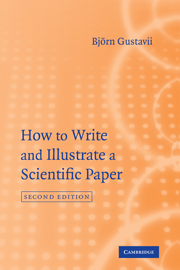Book contents
- Frontmatter
- Contents
- Preface
- Acknowledgments
- 1 Basic rules of writing
- 2 Comments on scientific language
- 3 Drafting the manuscript
- 4 Choosing a journal
- 5 Preparing a graph
- 6 Drawings
- 7 Figure legends
- 8 How to design tables
- 9 Title
- 10 Authors
- 11 Abstract
- 12 Introduction
- 13 Methods
- 14 Results
- 15 Discussion
- 16 Acknowledgments
- 17 References
- 18 Ph.D. and other doctoral theses
- 19 Letters and case reports
- 20 Numbers
- 21 Abbreviations
- 22 How to present statistical results
- 23 Typing
- 24 Dealing with editors and referees
- 25 Correcting proofs
- 26 Authors‘ responsibilities
- Literature needed on your desk
- Further reading
- Literature cited
- Index
1 - Basic rules of writing
Published online by Cambridge University Press: 05 June 2012
- Frontmatter
- Contents
- Preface
- Acknowledgments
- 1 Basic rules of writing
- 2 Comments on scientific language
- 3 Drafting the manuscript
- 4 Choosing a journal
- 5 Preparing a graph
- 6 Drawings
- 7 Figure legends
- 8 How to design tables
- 9 Title
- 10 Authors
- 11 Abstract
- 12 Introduction
- 13 Methods
- 14 Results
- 15 Discussion
- 16 Acknowledgments
- 17 References
- 18 Ph.D. and other doctoral theses
- 19 Letters and case reports
- 20 Numbers
- 21 Abbreviations
- 22 How to present statistical results
- 23 Typing
- 24 Dealing with editors and referees
- 25 Correcting proofs
- 26 Authors‘ responsibilities
- Literature needed on your desk
- Further reading
- Literature cited
- Index
Summary
Winston Churchill was sitting at his desk, working on his epic about World War II, when his private secretary entered the room. Churchill had reached the Blitz – the German air strikes against London. His staff of researchers had earlier produced a 150-page brief on the raids. The secretary had been asked to cut it down to about two and a half pages and, after having “worked like stink,” he could now proudly hand over the condensed version.
Churchill took out his red pen and started to edit. “All my sloppy sentences were tightened up and all my useless adjectives obliterated,” the secretary tells us in a documentary made about 50 years later (Bennet 1992). In the midst of it all, Churchill said gently, “I hope you don't mind me doing this?” The secretary answered, “Thank you, Sir – you are giving me a free lesson in writing plain English.”
Brevity
We should emulate Churchill by excluding every nonessential word. Professional writers do it that way. Brevity is an elementary rule of all writing, not only to save valuable publication space, but also because verbose writing obscures meaning and wastes the reader's time and patience. And that is also the essence of the next basic rule.
Logic and clarity
To convey information is above all a matter of logic and clarity. What you want to say should be so arranged that the reader can follow your argumentation step. Moreover, your sentences should be so clear and easily understood “that the reader forgets that he is reading and knows only that he is absorbing ideas” (Baker 1955).
- Type
- Chapter
- Information
- How to Write and Illustrate a Scientific Paper , pp. 1 - 2Publisher: Cambridge University PressPrint publication year: 2008
- 2
- Cited by



